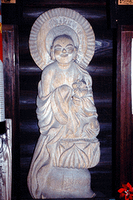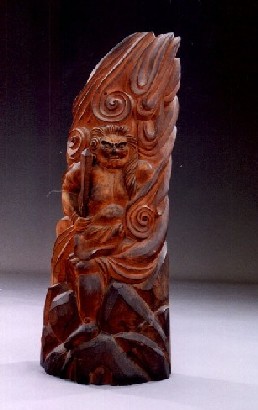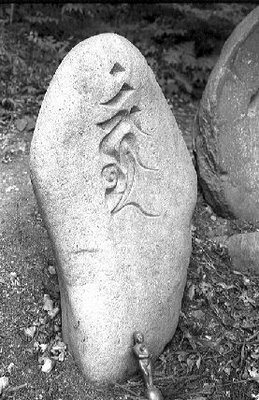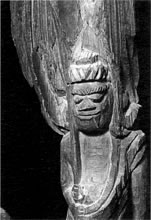[ . BACK to DARUMA MUSEUM TOP . ]
:::::::::::::::::::::::::::::::::::::::::::::::::::::::::::::::::::::::::::::::::::::::::::::::::::::
En no Gyooja 役行者 En no Gyōja
The Mountain Ascet En no Gyoja
kigo for late winter
En no Gyooja Ki 役行者忌
Memorial Day for En no Gyoja
The exact date of his death is uncertain, but is usually celebrated on the first of January.
. Memorial Days of Famous Poeple .

CLICK for more images !
- quote
En no Ozunu (役小角, also pronounced Ozuno or Otsuno (male; b. conventionally given as 634, in Katsuragi; d. approx. 700-707, reported details vary). His kabane, or political standing of his clan, was Kimi (君)) was a Japanese ascetic, mystic, and apothecary, who was banished to Izu Ōshima on June 26, 699 AD.
In folk religion, he is often called En no Gyōja (役行者, lit. "the Ascetic from the En clan") and traditionally held to be the founder of Shugendō, a syncretic religion incorporating aspects of Taoism, Shinto, esoteric Buddhism (especially Shingon Mikkyō and the Tendai sect) and traditional Japanese shamanism.
He is also known as
En no Ubasoku (役優婆塞).
© More in the WIKIPEDIA !
:::::::::::::::::::::::::::::::::::::::::::::::::::::::::::::::::::::::::::::::::::::::::::::::::::::
En no Gyooja and Shugendoo, an essay
En no Gyoja: idealized mountain ascetic
Curtesy from arvigarus.bravehost - no longer available
"Enlightenment" and "Nirvana"? They are dead trees to fasten a donkey to.
The scriptures? They are bits of paper to wipe the mud from your face.
The four merits and ten steps? They are ghosts in their graves.
What can these things have to do with you becoming free?
En no Gyoja as the idealized mountain ascetic was the prototype for the Yamabushi. His image and lore were key influences in the unification of many unorganized wandering ascetics into the new movement of Shugendo. The term Yamabushi directly translates into 'one who sleeps in mountains', and was used to describe those ascetics who, like En, chose the mountains exclusively as their ascetic training grounds. These men would withdraw from ordinary society in exchange for the benefits of rigorous mountain life. They would often maintain a special diet, such as pine needles mandated by Religious Taoism, to gain magical powers.
They would also subject themselves to physical trials such as standing under cold water falls for extended periods. These Ascetics sought out sacred mountains as a training ground (doba) and a shelter from society where they could freely put to use many different religious techniques. In Japan as with many east Asian cultures mountains themselves are considered sacred regions where deities reside. These unpopulated and unregulated areas of the country were seen a places where man could interact directly with nature and the spirits contained within.
Gary Snyder points out in his essay ,"Blue Mountains Constantly Walking" that there were a few highly formalized sacred areas which were modeled after a symbolic mandala. It was thought that to walk within these areas was to enact specific move within a spiritual plane. Hence we can see that these hills were not only sought out as a place of religious and spiritual freedom, but also the strong spirituality that was seen to be within the hills themselves.
Aside from the physical rigors the Yamabushi subjected themselves to, these men often memorized Buddhist Sutras, continually repeating certain phrases from these Sutras or Taoist magical formulas. There are three canonized Sutras which became integral parts of the Shugendo. The Lotus Sutra was adopted by Shugendo and has continued to maintain a special space within much of Japanese Buddhism. The Avalokitsvara (a recognized bodhisattva) Sutra was also adopted. I was unable to obtain any significant information about this Sutra at this time. The Yamabushi recited
the Heart Sutra daily as a part of morning prayers.
Along with this canonized sutra the Yamabushi would also recite The Sutra on the Unlimited Life of the Three fold Body, an apocryphal text attributed to En no Gyoja. The contents and messages of these sutras provide insight as to the core beliefs and values of the Yamabushi. The most evident belief present in all of these texts is the ability for each man to obtain and experience enlightenment first hand. It was not until much later that folklore attempted to legitimize the transmission of these teachings by linking
En no Gyoja to recognized teachers of Buddhism such as Nagarjuna. It seems as though the original Yamabushi were less concerned with matters of this nature, and more concerned with their own personal religious experience. It is not until the 9th century that scholars begin to take interest in the pedigree of their texts.
It is important to note that not until the 9th century time that formal religious adepts take interest in Shugendo as an organized religion. The original Yamabushi practitioners of the 7th and 8th centuries were of a more eclectic nature seeking out first hand religious experience. In the process obtaining this experience the they would appropriate fragments of the many different religious influences of the time and apply them to situations as needed. It is in this fashion that they adopted their own form of dress, with many attributes being drawn from Buddhist influences.
The
outfits of the Yamabushi often consisted of a Buddhist hood (tokin) and surplice (kesa), and a white robe (signifying purity). They also carried with them a Buddhist staff (shakujo) and a (oi), which is a portable alter in the form of a backpack filled with scriptures and other religious needs. Two other distinctly mountainous tools adopted and worn were an ax (ono) and a conch shell (hora). It is said that often times these Yamabushi would even borrow the rosary of the lay Buddhist monks. Unlike the lay monks the many of the Yamabushi did not practice celibacy nor did they wear the ritual shaved head. Our eclectic mountain men often took wives, and wore their hair long or untrimmed.
At this point we can observe the interesting scope of the formation and progression of Shugendo. Initially we have the practices of a single individual, En no Gyoja who became the embodiment of an idea that's time had come. These actions were enough to interest many wandering ascetics who were in search of a new personally attainable truth in the rigorous training and eclectic practices. Also unregulated personal and religious freedom of the mountains is a large draw. Soon these practices begin to evolve, slowly developing a distinct quality unique among the new mountain men. This unique assembly of thought and practice begins to attract the attention of the court and nobility, presumably the only ones aside from the wanderers, with sufficient leisure time to consider such matters. The interest of these educated nobility spawns the organized canons of the
Shingon and Tendai sects which eventually make the Shugendo religion and the mountain retreats accessible to the general populace.
This shift to a canonized and analytically smoothed-over doctrine eventually outmodes the original frontiersman of the Shugendo faith causing them to be seen as primitives or even dim caricatures of themselves. This learned and ritualized form of Shugendo flourishes for many years until much later (the 19th century), when a government sponsored religious reform makes Shinto Japan's official religion. In this shift Shugendo along with many other religions are forced to die out or remain in small secretive pockets. This outlines an archetypal progression from direct, unconscious or semiconscious experience of wonderment, to thought and analization, to death or reabsorbtion, leaving Shugendo essentially dead to experience and alive only as a shell or a fossil.
Shugendo was at one time a religion of true life and vitality. Beat poet Gary Snyder is a modern figure who fancied that he could still feel that vitality of the Yamabushi in their writings and in their ways. In his book of collected works entitled The Practice of the Wild he includes an entire piece on the Yamabushi which he hinges around Dogen Kigen's essay Sansuikyo, "Mountains and Waters Sutra" written in the year1240.
Snyder discusses Dogen 's interest in the mountains saying" Dogen is not concerned with "sacred mountains" or pilgrimages, or spirit allies, or wilderness as some special quality. His mountains and streams are the process of the earth, all of existence... They are what they are, we are what they are. For those who would see directly into essential nature, the idea of the sacred is a delusion and an obstruction: it diverts us from seeing what is before our eyes: plain thusness. Snyder provides us with some excerpts from Sansuikyo beginning with the opening paragraph. If we can strive to understand Dogen's sentiments the Shugendo vision may not be dead. In fact this very understanding can serve us as building block in all of our spiritual constructs, present, and future.
"The mountains and rivers of this moment are the actualization of the way of the ancient Buddhas. Each, abiding in its own phenomenal expression, realizes completeness. Because mountains and waters have been active since before the eon of emptiness, they are alive at this moment. Because they have been the self since before form arose, they are liberated and realized."
Mountains and Rivers Sutra
En the ascetic represented a spiritual ideal for the common folk unfettered by the corruption of power and money that is at the heart of institutionalized religion.
From the esoteric collection of Reverend
Dr. JC Husfelt:
(En-No-Gyoja with the Siddham letter Ham, seed-syllable of Fudo Myo-o.)
The following gives a brief over-view of Shugendo:
A blend of pre-Buddhist folk traditions of Sangaku shinko and Shinto, Tantric Buddhism, and Chinese Yin-yang magic and Taoism, Shugendo may be roughly defined as the 'way of mastering magico-ascetic powers by retreat to and practice within the sacred mountains'. Shugendo practitioners were called Yamabushi, a term which meant 'one who lies down or sleeps in the mountains' and the sect included various types of ascetics such as unofficial monks, wandering holy men, pilgrimage guides, blind musicians, exorcists, hermits and healers.
A leading scholar of Shugendo, H. Byron Earhart, explains that "In the early stages of the development of Shugendo the yamabushi usually were unmarried mendicants who spent most of their time in religious practice within the mountains; in later periods most yamabushi married and either had their temple homes at the foot of sacred mountains or made periodic trips of religious pilgrimage and ascetic retreat to the mountains...
When the yamabushi descended the mountains they visited their 'parishioners' to administer blessings from the mountain or perform special services of healing and exorcism. The yamabushi were adept in a variety of purifications, formulas, and charms. The religious goal of Shugendo was as diverse as its organization, technique, and procedure. In general it amounted to the utilization of religious power for every imaginable human need". Because of its loose organization, its lack of textual doctrine, and its appeal to the simple, illiterate folk people of the countryside, Shugendo became a popular movement throughout Japan from the twelfth century to the time of the Meiji restoration in 1868. According to one study, more than 90% of the village shrines in mid-northern and northeastern Japan were served by Shugendo priests. (Martin Gray’s Sacred Sites)
Throughout these mountains and this magical landscape of the yamabushi roams the heart and the spirit of their patron guardian,
the Brilliant Light King—Fudo Myoo-oo.
Gary Snyder best describes this great protector of the Shugendo brotherhood:
" Goma, fire ceremony, mudras hid under the sleeves, dark lanterns and earthen floor smells, the Yamabushi costume with the strip of deer or wild goat hide hanging down in back. And in some of the shrines, Fudo. Fierce and funny, sitting on a rock, backed by flames, holding the vajra-sword and a noose.
Fudo shrines on mountain tops, by waterfalls, and in temples, a patron of mountain ascetics, the popular Buddha-image of many rural provinces in the old central parts of Honshu. The Yamabushi have their own lore and practice of Fudo. For the other Buddhist followers, he is seen as a Dharma-protector, a grim but compassionate tough guy, punk or street-Buddha, no bullshit, the noose is said to be a lasso and save some folks from hell whether they want it or not, or said to be for binding up destructive passions. Actually the noose stands for The Precepts. The sword is the same sword as Manjushri wields, cutting through delusion and foolishness. Such a figure appropriate to this worst of centuries, a Buddha of enlightened determination who will not back off, who is not averse to confronting the mass murder of Ukrainians, of Jews, of Cambodians, and the threat of nuclear holocaust. Who can sit down with generals and dictators and talk even tougher than they. And then laugh about it, and convert and forgive.
And more technically, in Japanese iconography, he is seen as an emanation of Vairochana, the cosmic eternal Buddha, in a body to enact appropriate compassion and teaching, but also the consort perhaps and other side of the gentle and feminine image of Kannon, motherly, loverly, nourishing or challenging—compassion.
The Sanskrit name Chandamaharoshana, ‘Lord of Heat’ and read his old north Indian Vajrayana sadhana (visualization and practice exercise) and saw that he was a relatively minor, or at least little-known part of that iconography, an ally-figure? Minor perhaps, but enormously important. He is an emanation of the most powerful of emotions, instincts, and feelings, the deeps of the ‘red lump of flesh’—the roar of the Griz, the dying flurry of whole body of a whale, the deep-throated cry of sexual ecstasy, the cry of delight, the cry of pain, all—as illuminated and accepted and transformed by insight—as the strength and calm of active, dynamic, fearless mind-awakened willingness to fully act and be." (Contributions to the Ring of Bone Zendo Dharma Art Exhibit, September, 1987)
Fudo Myo-o-Messenger of Dainchi Nyorai (Great Sun)
about Kooya-San, read the story on the link.
Ku-kai, the founder of Shingon Esoteric Buddhism, is probably the most influential person in the history of Japanese religious thought. Dissatisfied with the state of religious and spiritual practice in Japan, Ku-kai in 804 C.E. traveled to China seeking something purer, uncorrupted by the politics and dogma of his time. His seeking outside the established lines of authority was due to his experiences with direct intuitive awakening. It was these experiences that helped shape his approach to the spirit and to Buddhism. And there was one primary event that is credited with his awakening:
In Indications of the Goals of the Three Teachings,
Ku-kai (Kuu-Kai 空海)tells of his own experience. "Believing what the Buddha says to be true, I recited the mantra incessantly, as if I were rubbing one piece of wood against another to make fire, all the while earnestly hoping to achieve this result. I climbed up Mount Tairyu in Awa Province and meditated at Cape Muroto in Tosa. The valley reverberated to the sound of my voice as I recited, and the planet Venus appeared in the sky." (Hakeda, pg. 102) In a moment of dramatic achievement, Ku-kai experienced a vision of the planet Venus with him as the Bodhisattva Akasagarbha who became his guardian saint. (R.S. Green, University of Wisconsin Buddhist Studies Ph.D. program student, 1999.)
Two years later, 806 C.E., Ku-kai returned from his journeys through China as lineage holder of an esoteric Buddhist tradition. This new religion based on his vision, experiences and studies, he deemed, "True Word" or Shingon. This Mikkyo, "secret teaching", form of Buddhism was dependent, in Ku-kai’s mind, on the power inherent when one transcends language and discovers the word spirit of the divine, what might be termed the nuclear seed-sounds of creation.
In 816 C.E. Ku-kai petitioned the government for permission to locate his new religion on the sacred mountain of Koya (Kooya-san高野山). "Two years later, Ku-kai climbed Ko-ya-san himself, at which time he is said to have met the local god of the mountain in the person of a hunter accompanied by two dogs, black and white. Several such legends exist, and native deities associated with Shingon are enshrined at various places on and around the sacred mountain. Ku-kai did in fact invoke the protection of local deities when he performed an esoteric ritual to establish a sacred realm of practice on the mountaintop. This consecrated area was named Kongobu-ji." (Shingon, pg. 30)
this site is no longer available : arvigarus.bravehost
:::::::::::::::::::::::::::::::::::::::::::::::::::::::::::::::::::::::::::::::::::::::::::::::::::::::
 . . . CLICK here for Photos !
- further reference -
. . . CLICK here for Photos !
- further reference -
:::::::::::::::::::::::::::::::::::::::::::::::::::::::::::::::::::::::::::::::::::::::::::::::::::::
Read my story about Yoshino and the Cherry Blossoms
http://darumapilgrim.blogspot.com/2005/01/yoshino.html
:::::::::::::::::::::::::::::::::::::::::::::::::::::::::::::::::::::::::::::::::::::::::::::::::::::
En no Gyoja
 . Negoro Temple 根香寺 Shikoku Pilgrimage Nr. 82 .
. Negoro Temple 根香寺 Shikoku Pilgrimage Nr. 82 .
:::::::::::::::::::::::::::::::::::::::::::::::::::::::::::::::::::::::::::::::::::::::::::::::::::::
[ . BACK to DARUMA MUSEUM TOP . ]
[ . BACK to WORLDKIGO . TOP . ]
:::::::::::::::::::::::::::::::::::::::::::::::::::::::::::::::::::::::::::::::::::::::::::::::::::::
 Having moved to Tokyo at the age of eight, Kanzan studied under Kanō Hōgai, and after Hōgai's death, under Hashimoto Gahō. He graduated first in his class at the Tokyo Bijutsu Gakkō (the forerunner of the Tokyo National University of Fine Arts and Music), and became a teacher at the same institution in 1894.
Having moved to Tokyo at the age of eight, Kanzan studied under Kanō Hōgai, and after Hōgai's death, under Hashimoto Gahō. He graduated first in his class at the Tokyo Bijutsu Gakkō (the forerunner of the Tokyo National University of Fine Arts and Music), and became a teacher at the same institution in 1894.













































